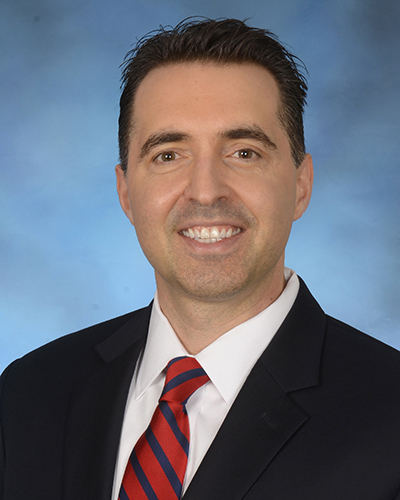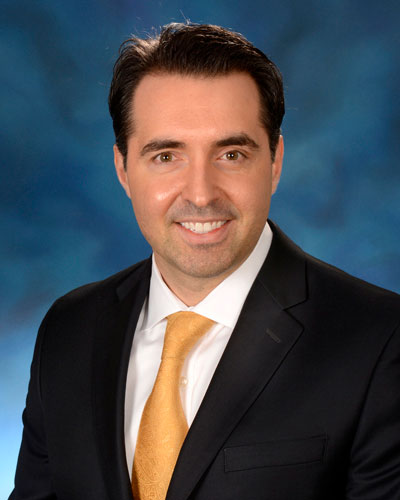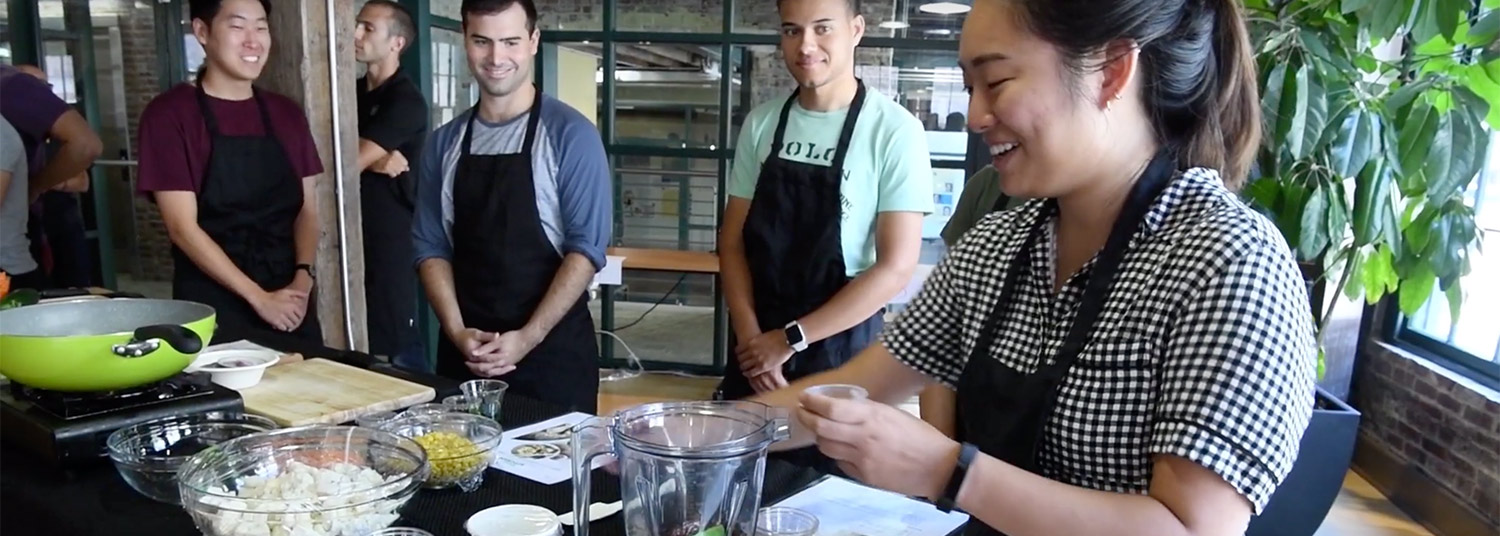August 05, 2021 | Deborah Kotz
Research Confirms Importance of Training Future Physicians in Nutritional Aspects of Patient Care
 Medical school students who took a three-hour culinary medicine training course reported feeling more confident in their nutritional knowledge and in their abilities to counsel patients on healthy eating habits, according to a new study from the University of Maryland School of Medicine (UMSOM). The study involved 119 UMSOM medical students who participated in a class that includes a nutrition lecture and cooking lessons in a demonstration kitchen at the Institute for Integrative Health, a non-profit organization based in Baltimore. Culinary medicine training is now required as part of the new Renaissance Curriculum instituted last year at UMSOM. The study was published last month in the American Journal of Lifestyle Medicine.
Medical school students who took a three-hour culinary medicine training course reported feeling more confident in their nutritional knowledge and in their abilities to counsel patients on healthy eating habits, according to a new study from the University of Maryland School of Medicine (UMSOM). The study involved 119 UMSOM medical students who participated in a class that includes a nutrition lecture and cooking lessons in a demonstration kitchen at the Institute for Integrative Health, a non-profit organization based in Baltimore. Culinary medicine training is now required as part of the new Renaissance Curriculum instituted last year at UMSOM. The study was published last month in the American Journal of Lifestyle Medicine.
To conduct the study, UMSOM researchers asked first-year medical students participating in a core curriculum culinary medicine course to complete a survey both before and after taking the three-hour training. They found students were more than twice as likely to report being prepared for providing healthy eating recommendations to patients after taking the class, as compared to before taking the class.
“A robust two-thirds of medical school students felt prepared or very prepared to interact with patients to discuss healthy eating after taking this one class. This suggests that culinary medicine training in medical school is feasible, well accepted, and associated with improvements in nutritional knowledge,” said study lead author Christopher D’Adamo, PhD, Assistant Professor of Family & Community Medicine at UMSOM and Director of the Center for Integrative Medicine.
Guiding patients to pursue healthier eating habits can help prevent obesity as well as diseases that frequently result from poor diets such as heart disease, strokes, and cancer, he added.
The study found that 12 percent of students reported feeling “very prepared” for these interactions after taking the class, compared to 5 percent of those who had not yet taken the class; an additional 55 percent felt “prepared” after the class, compared to 34 percent before the class.
It also found that none of the students reported feeling “not at all knowledgeable” about nutrition after the course, compared with nearly 5 percent who felt that way before taking the class. Students also reported that the class gave them practical tools for providing advice to their patients, including how to address barriers to healthy eating such as living in a low-income area where fresh produce can be scarce.
Healthy eating and other self-care modalities can also benefit the medical school students themselves: Studies suggest self-care helps reduce stress among medical students and reduces symptoms of depression, burn-out, and other mental health challenges associated with the demanding coursework.
“The strategies for overcoming healthy eating barriers that were presented in our course – including time, taste, cravings, and cost challenges – are also applicable to medical students. They reported these strategies were relevant to their own lives,” Dr. D’Adamo said.
Study co-authors included Norman Retener, MD, Assistant Professor of Medicine at UMSOM, Bernadette Siaton, MD, Assistant Professor of Medicine at UMSOM, and Brian Berman, MD, Professor Emeritus of Family & Community Medicine at UMSOM.
“This study provides scientific evidence to support important aspects of the new curriculum that we instituted last year in our medical school,” said E. Albert Reece, MD, PhD, MBA, Executive Vice President for Medical Affairs, UM Baltimore, and the John Z. and Akiko K. Bowers Distinguished Professor and Dean, University of Maryland School of Medicine. "Our coursework focuses on actualizing the Renaissance Physician. This kind of physician serves as an important guide for patients who are eager to feed themselves and their families with meals that are nutritious, delicious, and affordable.”
About the University of Maryland School of Medicine
Now in its third century, the University of Maryland School of Medicine was chartered in 1807 as the first public medical school in the United States. It continues today as one of the fastest growing, top-tier biomedical research enterprises in the world -- with 46 academic departments, centers, institutes, and programs, and a faculty of more than 3,000 physicians, scientists, and allied health professionals, including members of the National Academy of Medicine and the National Academy of Sciences, and a distinguished two-time winner of the Albert E. Lasker Award in Medical Research. With an operating budget of more than $1.2 billion, the School of Medicine works closely in partnership with the University of Maryland Medical Center and Medical System to provide research-intensive, academic and clinically based care for nearly 2 million patients each year. The School of Medicine has nearly $600 million in extramural funding, with most of its academic departments highly ranked among all medical schools in the nation in research funding. As one of the seven professional schools that make up the University of Maryland, Baltimore campus, the School of Medicine has a total population of nearly 9,000 faculty and staff, including 2,500 students, trainees, residents, and fellows. The combined School of Medicine and Medical System (“University of Maryland Medicine”) has an annual budget of over $6 billion and an economic impact of nearly $20 billion on the state and local community. The School of Medicine, which ranks as the 8th highest among public medical schools in research productivity (according to the Association of American Medical Colleges profile) is an innovator in translational medicine, with 606 active patents and 52 start-up companies. In the latest U.S. News & World Report ranking of the Best Medical Schools, published in 2021, the UM School of Medicine is ranked #9 among the 92 public medical schools in the U.S., and in the top 15 percent (#27) of all 192 public and private U.S. medical schools. The School of Medicine works locally, nationally, and globally, with research and treatment facilities in 36 countries around the world. Visit medschool.umaryland.edu
Contact
Deborah Kotz
410-706-4255
dkotz@som.umaryland.edu
Related stories

Monday, November 04, 2019
UM School of Medicine has New Requirement for Students: Culinary Medicine
First- and second-year medical students at the University of Maryland School of Medicine (UMSOM) have a new requirement this year in order to earn their medical degree: culinary medicine. Among the first medical schools in the nation to implement the required course, UMSOM aims to increase future physicians’ nutrition knowledge through a class that combines didactic lectures on the evidence supporting many different approaches to healthy eating with experiential techniques that involve the proper chopping of onions, sautéing of vegetables, and garnishing of freshly baked salmon.

